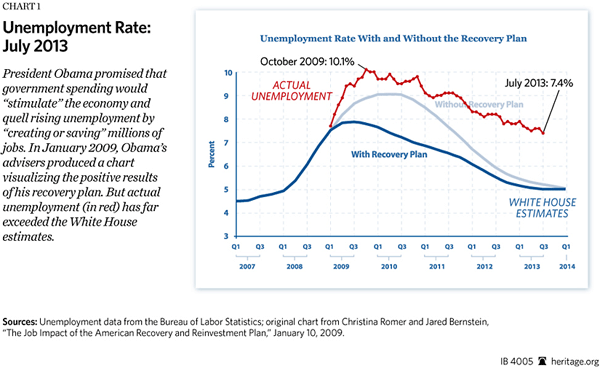The Bureau of Labor Statistics employment report found steady but disappointing growth in the labor market in July. Employers added 162,000 net jobs, and the unemployment rate fell slightly to 7.4 percent. While this would be considered decent growth in normal economic times, it falls short of expectations for a recovery from a deep recession. However, part-time workers are not being converted to full-time at the rate seen in previous recessions.
Moreover, as expected, the budget-cutting sequestration has had few adverse economic effects. Since sequestration took effect March 1 the labor market has continued to expand while federal employment has fallen by less than two percentage points.
July Employment Report
The July employment report showed modest but positive economic progress across the board. The household survey reported unemployment falling 0.2 percentage points to 7.4 percent, the lowest since December 2008 and down a full percentage point from December 2011. The household survey showed that the population grew by about the same amount as the number of people employed. The number of unemployed fell to 11.5 million, its lowest point since 2008.
However, the economy remains weak. At 58.7 percent, the July employment-to-population ratio remains little changed from the very worst of the recession. The improvement in unemployment since the end of the recession comes predominantly from workers leaving the labor force, and in July labor force participation dropped as 37,000 people left the labor force.
The modest job growth has only sufficed to keep pace with population growth. In 2009, the Obama Administration promised that the huge increase in government spending from the stimulus would lead to recovery and low unemployment within a few years. Instead, four years later, unemployment remains persistently high.
The payroll survey paints a similar picture of good but modest growth. Employers added 162,000 jobs, with the largest gains coming in retail trade (+47,000) and food service and drinking places (+38,000). Employment also expanded in professional and business services (+36,000), wholesale trade (+14,000), and financial activities (+15,000).
Employment in manufacturing, construction, government, and health care was flat. Revisions to the robust May and June employment reports lowered estimates of job gains (–26,000).
Average weekly hours declined slightly and have hovered at the same level since the end of 2010. Hourly earnings remained constant, showing an annual increase (1.8 percent) slightly above the rate of inflation (1.6 percent).[1]
Part-Time America?
An analysis of the part-time work situation by Chris Conover of Duke University showed that the typical decline in part-time work has been attenuated in the current recovery.[2] As more and more employers announce that their employees will be kept below the 30-hour maximum that Obamacare sets for part-time workers,[3] evidence is mounting that the perverse incentives in Obamacare are decreasing demand for labor, especially full-time labor.
Because the 30-hour limit and employer insurance mandate will not take effect until 2014 (according to the law) or 2015 (according to the Obama Administration),[4] most employers have not yet adjusted their scheduling to comply with the law’s harmful incentives. But those employers that have announced changes—from White Castle fast food restaurants[5] to the city of Long Beach, California[6]—are the canaries in the coal mine, indicating how many other employers will respond when enforcement of the law is imminent.
Presently, the number of workers who are part-time for economic reasons—those who can find only part-time work or whose hours are held below full time because of “slack work or business conditions”—is above 8 million. That represents a decline of less than 10 percent from its 2009 peak.[7] In the comparably severe 1982 recession, the number of part-time workers dropped more than 10 percent in the first year of recovery as full-time employment surged. Previous recessions showed a similar pattern.
Maddeningly Slow
Today’s jobs report shows that the labor market continues to grow at the same rate as the population, with no signs yet of the kind of acceleration needed to restore full employment. The decline in government employment has not shown any drag on the private sector, but the looming Obamacare employer mandate may be preventing the usual conversion of part-time jobs to full-time ones.
—Salim Furth, PhD, is Senior Policy Analyst in Macroeconomics in the Center for Data Analysis at The Heritage Foundation.




